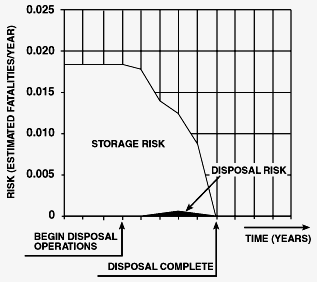


The risk associated with destroying the U.S. chemical weapons stockpile
is relatively low in comparison to the risk of continuing to store the
weapons.

Given an aging U. S. stockpile of lethal chemical weapons located at storage depots in eight separate states, what is the "best" disposal strategy from the perspective of the nation as a whole?

Oak Ridge National Laboratory provided technical support to the U.S. Army by preparing a Final Programmatic Environmental Impact Statement (FPEIS) that assessed the potential environmental impacts of alternate approaches to destroying the U.S. inventory of chemical weapons.
Consistent with a Congressional directive, the principal focus of the FPEIS was an integrated interdisciplinary analysis and comparison of several alternatives: (a) on-site disposal at the present storage locations, (b) transportation of the site-specific inventories by rail to two regional disposal centers, (c) transportation of the inventories by rail to a single national disposal center, and (d) a "no- action" alternative (i.e., continuing to store the stockpile). Other alternatives that were subjected to analyses included other modes of transportation (e.g., air, truck, and barge) and alternate destruction technologies (e.g., incineration and cryofracture).
It was concluded that the U.S. chemical weapons stockpile could be destroyed in a safe, environmentally acceptable manner and that the risk of catastrophic accidents would be relatively low for all programmatic disposal alternatives. On-site disposal was found to pose less risk to the public and to the environment than alternatives involving transportation of the stockpile and was therefore selected as the best choice for the destruction of the U.S. stockpile of chemical weapons.

U.S. Department of the Army. 1988. Chemical Stockpile Disposal Program Final Programmatic Environmental Impact Statement (Vols. 1, 2, and 3). Program Executive Officer--Program Manager for Chemical Demilitarization. Aberdeen Proving Ground, Md.
Integrated Assessment Briefs. 1995. ORNL/M-4227. Oak Ridge National Laboratory, Oak Ridge, TN.